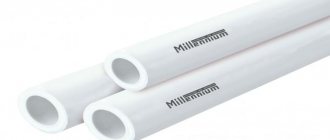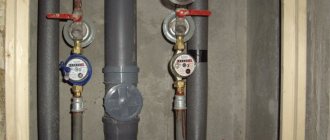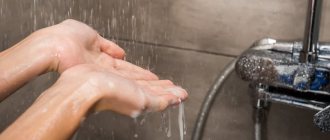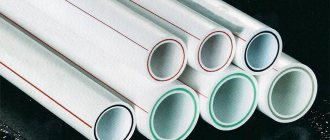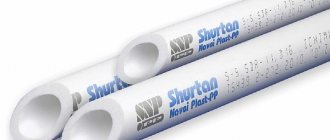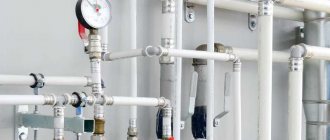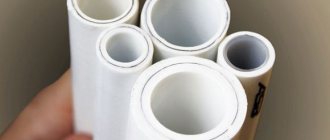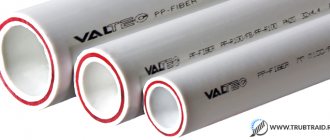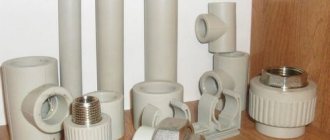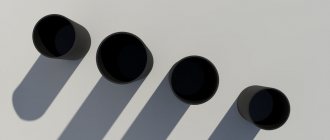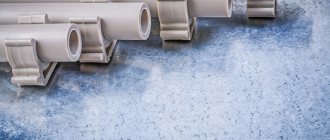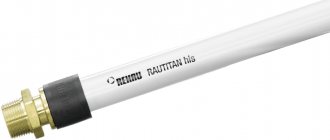Metal pipes, which have long been used for water supply and heating in our houses and apartments, are being replaced by pipes made from modern materials. Today, polypropylene pipes have proven themselves to be excellent for cold and hot water supply. Let's consider how reliable and safe the use of polypropylene is in pipelines. Polypropylene pipes are able to withstand high pressure (main networks), high temperatures (up to 95 °C continuously and up to 110 °C for a short time), and remain intact during freezing and thawing.
Types of polypropylene pipes
The construction industry is constantly developing, and today, instead of metal ones, when organizing engineering systems, in most cases various types of polypropylene pipes and fittings are used.
They can be used for installation of pipelines for supplying process and drinking water, transporting coolants, aggressive media, compressed air, irrigation, drainage, ventilation of administrative and residential buildings, in the agricultural sector, and in various gas production facilities.
- Structurally, polypropylene pipes are produced in two types:
- solid;
- reinforced (combined).
Reinforcement makes it possible to reduce thermal expansion, which is significant for solid pipes.
- Manufacturers use several reinforcement methods:
- Covering the outside of the pipe with a layer of aluminum foil.
- Installation of a layer of aluminum inside the pipe, closer to the outer edge.
- Fiberglass reinforcement.
- Reinforced with a layer of composite material made of polypropylene and fiber or glass fiber.
Solid polypropylene pipes
The difference between polypropylene pipes of this type is the different raw materials used for their production, as well as their application. Differences in technical characteristics are reflected in the markings.
Marking meaning:
PN marking means constant internal water pressure at a temperature of 20°C, which pipes can withstand for 50 years. The digital value corresponds to the wall thickness (the higher the value, the thicker the walls).
Polypropylene pipes PN 10, 16, 20, 25 are the most common. PN 20 and 25 are intended for installation of heating and hot water supply systems.
The presence of a longitudinal blue stripe indicates their purpose for transporting cold water, while the red stripe indicates hot water.
- The PP marking indicates that the pipe material is polypropylene:
- PPH, PP-1, PP-type 1 – homopolymer. RPH - used for cold water supply and ventilation.
- PPV, PP-2, PP-type 2 – block copolymer. RRV – designed for hot water supply and heating.
Polypropylene pipes PPRC, PP-random, PPR are made from the latest material “random copolymer”. PPR is the most common and is suitable for all types of utilities. Such pipelines have increased heat resistance.
For installation in open areas, it is advisable to choose pipes with a protective sheath against ultraviolet radiation.
With aluminum reinforcement
- Reinforcement with aluminum foil can be:
- solid;
- perforated.
Aluminum perforation is a mesh with small holes. During extrusion, a flowing viscous material entering the perforation creates adhesion between the polymer and the metal.
Aluminum reinforcement significantly reduces the thermal expansion coefficient, but there are certain difficulties when installing engineering systems. Socket welding involves preliminary removal of the aluminum shell and outer layer of polymer and stripping of the pipe to an amount corresponding to the depth of its insertion into the fitting.
- There are also pipes that do not require removal of the outer layer during installation, but they also have a number of disadvantages:
- Only the outer layer, equal to half the wall thickness, is attached to the fitting;
- a nozzle for a welding machine is required;
- After cutting the product, it needs to be trimmed.
Glass fiber reinforced
A pipe marked PPR-FB-PPR consists of two layers of polypropylene and fiberglass between them - the so-called “fiberglass”.
- A pipe with fiberglass reinforcement has a number of advantages over aluminum reinforcement:
- There is no need to calibrate or clean them during installation.
- The soldering process is similar to joining solid plastic pipes or any stripped polymer pipes, which significantly reduces financial and time costs.
- Polypropylene with glass fiber do not delaminate, since their structure is homogeneous - glass fiber in the central layer is fused into polypropylene.
- Fiberglass increases the rigidity of products.
The disadvantage of fiberglass pipes is that their thermal elongation is 6% higher than that of aluminum reinforcement.
Typical wiring diagrams
There are many circuit solutions for laying out water supply lines made of propylene. Each of the individual schemes is usually considered taking into account the financial costs of construction and with an eye to the technical requirements for the premises of the facility.
Most often, a classic wiring diagram is used, which is the same type in relation to the cold water and hot water lines.
Standard scheme for distributing cold/hot water in municipal buildings. Such solutions are more common than others. However, in private houses the scheme may differ slightly due to a different layout of residential premises (+)
Water is supplied from the riser of the centralized main through a pipe outlet with a shut-off valve installed on it. Next, the system elements are sequentially mounted: filter, reducer, meter, check valve and connected to the distribution manifold.
From the collector, cold or hot water is distributed to plumbing fixtures. This solution is traditionally used when installing water pipes in an apartment.
Many private households use an autonomous water supply system. Therefore, a departure from traditional circuit solutions in such cases is not excluded. But usually the principle of collector distribution for water supply systems (not heating) remains the same in any case.
Private household boiler systems often provide only a cold water supply. Moreover, instead of a centralized main, the source of cold water can be, for example, a well. Then the wiring diagram could be something like this:
A common circuit design for water supply distribution in a private house. Only one main input is used here - cold water. Hot water is obtained through a boiler system (+)
The wiring diagram in any embodiment must provide for the presence of shut-off (shut-off) valves for each individual plumbing fixture. Autonomous type schemes (with boilers or boilers) are characterized by the mandatory presence of bypass lines on devices that carry out a functional process.
Such solutions allow you to quickly switch the system from autonomous mode to centralized supply mode if necessary.
Read more about plumbing in a private house in this article.
Which polypropylene pipes are better?
- The criteria for choosing polypropylene pipes depend on their area of application and are different for:
- cold water supply;
- hot water supply;
- heating.
For water supply
When figuring out how to choose polypropylene pipes for water supply, it is important to take into account not only the characteristics common to all products of this type, but also the features of various types.
It is also important to ensure that the water supply components comply with the operating conditions (hot and cold water supply, permissible temperature range). Strength in this case is determined by the type of reinforcement.
Polypropylene pipes for cold and hot water supply have become popular and widely used due to their advantages.
Products for cold water and hot water are different. The classification and brief description of the properties will help you navigate your choice.
- By design, polymer products of this type can be single or multilayer.
- Type 1 (PPH) is made from a special type of polymer - homopolypropylene. Type 1 pipes are used for industrial water pipelines, ventilation systems, and cold water pipelines.
- Type 2 (PPV) is made from polypropylene block copolymer. They are used for installation of floor heating systems and cold water supply. Fittings and pipes are suitable for assembling systems subject to shock loads.
- Type 3 (PPR) – random copolymer polypropylene pipes. The material is characterized by the most uniform distribution of the load acting on the walls. The products are used for hot and cold water supply and floor heating systems.
Please note: Type 3 pipes in open areas will last longer if selected with ultraviolet protection (special casing).
The third type is PPS pipes - with high heat resistance. Such products allow you to transport the working environment up to +95°C and are classified as non-flammable.
When choosing polypropylene pipes for water supply, it should be taken into account that multilayer pipes are made from the same materials described above, but have additional reinforcement, which definitely affects their characteristics.
Reinforcement reduces the coefficient of thermal expansion of structures. By design, the reinforced aluminum layer of the product can be smooth or perforated. In the second case, the adhesion of the polymer to the metal at the production stage is ensured by the flow of the polymer into the small holes of the aluminum mesh shell.
- Marking of polymer pipes for water supply allows the buyer to quickly determine whether this product is suitable for him or not:
- PN-10 are intended for cold water and the construction of “warm floors” (up to a temperature of +45°C).
- PN-16 is suitable for installing “warm floors” or hot water; the brand is unpopular among craftsmen.
- PN-20 are designed for hot water supply with a maximum temperature of up to +80°C.
- PN-25 are the most durable, they can withstand water temperatures of +95°C.
For heating
Before purchasing polypropylene heating pipes, it is better to familiarize yourself with their technical parameters, scope of application and price-quality ratio. After all the pros and cons are taken into account, you can choose the most optimal product option.
- Pipe products made of polypropylene according to their design characteristics are divided into:
- single-layer;
- multilayer.
- Products of the first type are classified by type:
- PPH. The simplest type of polypropylene pipes for installing industrial systems, ventilation and water supply systems (cold water supply).
- PPV. They are produced on the basis of a blocksomer polymer compound used to install a system of heated floors and cold water supply. This material is better suited for the manufacture of mechanically resistant joints.
- PPR. They are made from random copolymer/polypropylene, widely used in cold water supply and various heating systems.
- PPs. A separate type of plastic product that better withstands heating of the environment up to 95 degrees.
Multilayer heating pipes include reinforced polypropylene products consisting of a durable interlayer frame.
Their main advantage is the ability to reduce temperature load changes in the pipe.
In practice, for heating devices it is better to use polypropylene pipe products reinforced with foil.
- There are 2 types of such products:
- reinforced;
- smooth.
The main disadvantage of reinforced heating pipelines made of polypropylene is the need to strip the foil insert before soldering, since the presence of the insert reduces the reliability of the seam in the structure. At the same time, there are types with deep placement of the insert, in which it is better not to strip them.
But still, taking into account all the advantages of polypropylene products for heating, there are a number of significant shortcomings regarding the process of connecting elements. When installing the structure, it is better to install pipes, which can only be done efficiently by a qualified craftsman.
It should also be remembered that during the welding process, layers of pipe half the wall thickness are joined.
When choosing polypropylene products and components for them for a heating system, it is necessary to take into account the scope of application, temperature limits of the working environment and installation conditions.
- There are several features that are best taken into account when choosing pipes:
- When installing polypropylene heating, you should use a special soldering iron.
- The market offers a wide variety of components made from this material (fittings, couplings, adapters, tees, 45, 90 degree angles) that are required elements.
- Connecting fittings made of white and gray polypropylene work best for installing water supply systems and heating systems.
When choosing pipe products made of polypropylene, you should familiarize yourself with the features of their characteristics and the possibility of application. Only after this will it be possible to determine which pipe is best suited for heating installation. For each type, the manufacturer includes detailed instructions and a description of the intended purpose.
It is better to trust the installation of polymer-based heating only to highly qualified craftsmen with experience.
Which polypropylene is better not to use for heating
Now we will determine polypropylene pipes, which are best not to be used for arranging certain heating systems.
Polymer products are classified according to the pressure and temperature of the working environment. The cheapest type of heating pipes is designed for a pressure level of 10 atmospheres and is designated PN-10.
The thickness of the polypropylene wall is from 2.5 to 2.8 millimeters, so it is better not to use these in a heating system, but to use them only for supplying cold water.
The next type of plastic with a thickness of 3 to 3.2 millimeters is designated PN-16 and is designed for a pressure level of up to 16 atmospheres and a working environment temperature of up to 80 degrees.
Next in the classification are polypropylene pipes with a wall thickness of up to 4 millimeters. They are designated PN-20 and can be used at atmospheric pressure up to 20 atmospheres and working fluid temperature from 80 to 85 degrees.
These pipes are best used for the water supply system: thin-walled for supplying cold water, and thick-walled for hot water. But the listed samples are not used for heating. The main reason is the large linear expansion, in which some sections of the pipeline will bend under the influence of high temperature.
About leaks, fistulas and other reviews about polypropylene
On professional construction forums, many horror stories are told about polypropylene leaks. The climax is a video where a man breaks pipes on a comb like dry rods. Any novice plumber or home craftsman will immediately disown this technology. What can I say, experienced craftsmen are confused by such arguments.
The reason for such defects, oddly enough, is savings on pipes and components. Currently, many products are sold from “basement” factories, for which technical descriptions cannot be found. Please note: if you decide to use a PP-ALUX pipe, for example, from a little-known manufacturer, the data in the pressure and temperature table above does not necessarily apply to your brand. No one exempts you from studying technical documentation from a specific pipe manufacturer.
It follows from this that many “plumbers” do not bother studying the characteristics of pipes. And this can lead to errors in soldering and installation. By the way, despite the simplicity of the technology, it must be performed with due care, observing the soldering temperature and other nuances. I have seen a lot of pipes soldered by “shabashniks” - in the vast majority of cases, the soldering was done with overheating, the pipe was incorrectly selected for a specific task.
I had to dismantle a lot of plastic pipes and I didn’t come across the horror stories described on the Internet. The pipes, after 5-10 years of operation, were in excellent condition; no cracks or destruction of the material were observed from the inside. Most often, the places where the leak occurred were poorly soldered connections, despite the fact that a properly soldered connection is much more reliable than the pipe itself. In simple terms, it’s hard for me to imagine such “hand-assed” installers. Nevertheless, there are a lot of such installers - they showed the technology, and simply said - this is the end of the worker’s qualifications. Hence all the ensuing consequences and problems, as well as the tarnished reputation of polypropylene.
Also, polypropylene owes its tarnished reputation to marketers who are actively promoting cross-linked polyethylene
. By the way, cross-linked polyethylene is not as resistant to high temperatures as it seems from beautiful stories. The job of marketers is to emphasize the advantages and gloss over the shortcomings of their product, and comment on the opposite about the competitor’s product. Everything is simple, just study the technical documentation for both products and everything will fall into place.
We will look at soldering polypropylene separately, but that’s all for now. And once again, I strongly recommend that you carefully select all materials for rough plumbing, beware of fakes and approach the issue thoroughly.
]]>
Characteristics of polypropylene pipes
- The main advantages of polypropylene products:
- Significantly lighter weight than metal pipes, which makes them much easier to transport and install.
- Non-susceptibility during operation to corrosion, blockages, and exposure to aggressive environments.
- Quick installation without the use of complex equipment or the need for specialized skills.
- Service life up to 50 years.
- Many types of polypropylene pipes have soundproofing properties.
- Absolute environmental safety.
- Despite the many advantages, polypropylene products have a number of disadvantages:
- High coefficient of thermal expansion (for reinforced ones - 2-3.5 mm per 1 m, for solid ones - 4-5 times more).
- The need for pre-treatment of pipes and fittings with external reinforcement using special equipment.
- The presence on the market of low-quality materials with defects in the outer layer.
- The difference between polypropylene pipes and similar products is their high fluidity, which is why they can deform over time even from their own weight. In this regard, they are mounted with fastenings every 50-60 cm.
- Since polypropylene pipes are quite rigid in bending, when assembling systems from them, a large number of rotary fittings are required.
What pressure do they hold?
Indicated in the marking of the heating pipe after the letters PN. If the marking indicates PN20, this means that the polypropylene product is designed for an atmospheric pressure level of 20 atmospheres, and, accordingly, PN25 - for 25 atmospheres. These samples can withstand maximum pressure and long operating conditions, but even at peak pressure they will not collapse.
Of course, for extreme loads it is better to use polypropylene products marked PN25, since with increasing temperature the strength of the heating pipe coolant decreases significantly.
So, at a temperature of 90 degrees, the pressure for a sample marked PN20 will no longer be 20 atmospheres, but approximately 6.5 kgf/cm². But in a heating system, this category of pipes remains capable of performing its assigned functions.
What diameters are there?
When drawing up a diagram of a polypropylene pipeline, it is better to focus on the diameter. When installing a heating system, the results of hydrodynamic calculations should be taken into account.
The main goal when carrying out calculations is to select a pipe with a minimum diameter size, taking into account the pressure of the working environment and the overall design of the heating system.
For example: Heating pipes with a large diameter, from 200 millimeters in size, are used in the construction of residential buildings, hotels, saunas, hospitals, shopping centers and other buildings designed to accommodate a large number of people.
Products made of polypropylene with a diameter of 20 to 32 millimeters are relevant in private construction due to their high throughput and the ability to give any bending shape.
It is recommended to use plastic pipes with a diameter of 20 mm for supplying hot water, and 25 mm for installing risers. When constructing a central heating system, it is better to use polypropylene samples with a diameter of 25 mm; for autonomous heating, this figure may fluctuate.
To install heated floors, it is recommended to use polymer pipes with a diameter of no more than 16 mm.
Inner diameter of polypropylene pipes (table)
Before designing a pipeline, you need to know what diameter of polypropylene pipes will be used. There is a complex hydraulic calculation. His goal is to choose the right size for each plot in order to save money when purchasing.
The calculation takes into account the operating pressure and structure of the system. A large cross-section, of course, will not harm, but it will be very expensive. If the cross section is too small, the pressure will decrease.
What diameters of polypropylene pipes are there? From 16 to 1200 mm! However, for domestic water supply and heating systems, products with a diameter of 16 to 32 mm are used, for internal sewerage - from 40, 50 mm to 110 mm.
The maximum diameter of polypropylene pipes is relevant when installing external sewer pipelines for very large houses or entire neighborhoods.
When designing an internal cold water supply system, the choice of size depends on the length of the pipeline and the number of water supply points. The supply pipe most often has a size of 32 mm; for indoor distribution, the outer diameter is 16 - 20 mm.
No less important is such an indicator as wall thickness. The internal diameters of polypropylene pipes depend on it. The table will help you understand the variety of sizes:
Scope of application
Polypropylene reinforced pipes are suitable for installation:
- heating systems in centralized heating networks, private houses;
- hot water supply pipelines;
- industrial pipelines for transporting aggressive substances and food liquids (without heating).
The main consumer of polypropylene reinforced pipes is the private homeowner. Plastic products best meet the needs and capabilities of consumers. They maintain maximum service life in conditions of autonomous heating communications, are inexpensive, easily transportable, and available for self-installation, maintenance, and repair.
Note! Polypropylene pipes (even reinforced ones) are not recommended for installation in centralized heating systems in cold regions. Significant temperature changes and high loads negatively affect the durability of plastic communications.
DIY installation of polypropylene pipes for water supply
Before starting work, it is necessary, after careful measurements, to cut the workpieces to the required length, and also prepare the fittings necessary for assembly.
- Installation of a water supply system involves the use of the following components:
- Couplings are used to extend straight pipes.
- Angles - used at turns to change the direction of laying the network.
- Tees, crosses - for arranging branching wiring.
- Contours - used to go around obstacles at the intersection of water supply elements.
- In addition to the above, you can purchase other components, such as brackets for mounting to walls, intermediate taps, adapters from size to size and other necessary parts.
- The process of soldering pipes with connecting elements during pipeline installation is not particularly difficult, but requires precise execution of all process parameters.
First of all, you need to check the compatibility of the elements. The two parts to be joined must not fit into each other when cold. If this happens, it means the parts are defective or incorrectly selected.
Next, you need to prepare a soldering iron. To do this, heating elements are installed on it: for the fitting there is a mandrel that heats it from the inside, for the pipe there is a coupling that heats the end from the outside. The operating temperature of the device is 260 degrees.
Before installing the pipe, you need to chamfer the front end along the outer contour of about 1 mm at an angle of 45 degrees. This will ensure smooth passage of the product into the fitting hole.
It is important to prevent overheating of the mating surfaces - solid, unheated material must be preserved under the molten layer. Here it is important to maintain the heating time, which will be given below.
After warming up, both parts are removed from the soldering iron and joined together with a counter movement of the hands. Within a few seconds, the material hardens, forming a strong, permanent connection.
A sign of a correct connection is a small, about 1 mm, bead inside and outside the joint. It will not interfere with the passage of water through the pipeline.
When parts overheat, a “skirt” is formed inside the joint, significantly preventing the passage of liquid. This connection is short-lived.
The method of connecting pipes end-to-end is also used, without the use of couplings. This installation method is used less frequently, since it requires rather complex equipment for trimming the joined ends, and the reliability of the joint is lower than when using fittings.
For a successful connection, the soldering iron must be firmly and securely mounted on the workbench. Its readiness for operation is determined by the color of the indicator light; if it is red, it means the device is heating up; when green lights up, it indicates that the operating temperature has been reached.
During the installation process, some of the elements are assembled into separate sections on a workbench; this is easy and convenient. But the installation of the assembled sections into the system has to be done while holding the tool suspended. It's hard to get by with an assistant here.
The cold assembly method is also used using adhesives based on strong chemical solvents of polypropylene. When it is applied to the surfaces of parts, the material softens.
In this condition, the individual parts are connected in the desired position. Since the solvent is very volatile, it quickly evaporates and reverse polymerization occurs, due to which the parts are joined. The adhesive joining method has many limitations and must be used carefully.
Conclusions and useful video on the topic
You will learn useful tips on proper welding of PP pipes from the following video clip:
It is obvious that the introduction of polypropylene pipes into the composition of constantly used plumbing materials was a kind of technological revolution. From now on, it became possible to build water pipelines with a high economic effect. At the same time, reliability and quality remained at the level of the same metal pipes.
The only limitation for propylene is temperature. But in the domestic sector, the temperature parameters are quite consistent with the characteristics of polypropylene pipes.
Do you have personal experience installing water pipes from polypropylene pipes? Do you want to share your accumulated knowledge or ask questions on the topic? Please leave comments and participate in discussions - the feedback form is located below.
Tools for installing polypropylene pipes
- Tools for installing polypropylene pipes can be divided into:
- welders;
- pipe cutters (scissors);
- stripping.
Scissors
- There are several types of scissors for cutting plastic pipes, but they all have almost the same design:
- the blade, usually made of stainless steel, is designed for cutting; the handles can be with a rubberized insert for greater convenience and reliable grip of the pipe;
- support that ensures precise cutting at right angles;
- a toothed rack-blade that facilitates cutting, a button or device that controls the opening of the scissors;
- lock for storing scissors when closed.
Many companies are developing and improving the quality of the tool and its aesthetic appearance. The knife blade can be sharpened at a special angle, which makes it easy to cut pipes. The design of the scissors can be improved with a push-button automatic blade retractor.
When installing plumbing and other systems, plastic pipes of various diameters are used, for example, from 3 mm to 42 mm. A tool for cutting plastic pipes, for example, Caliber, Kalde D20-40 mm and other companies, can easily cope with this size.
For larger diameters (63 mm), it is necessary to choose more powerful scissors. The power of the tool is determined by the diameter of the plastic pipe. Scissors, when used correctly, are a reliable and durable tool.
Welding machine
For strong and reliable connections of polypropylene pipes, special welding machines are used, which are used today by amateurs and professionals.
Such devices are used both for the installation of a small house pipeline system and for the creation of fairly extensive industrial facilities. It is as easy to buy a machine for welding plastic pipes in Ukraine today as any other construction tool.
Pipes can be welded in several ways: socket welding, socket welding and butt welding.
Butt welding is the most economical because it does not require anything else besides the welding machine itself. Devices for such welding operate on the principle of heating the ends of the parts that are being welded, followed by their connection using pressure.
Socket and socket welding takes place using additional parts. A machine for sleeve welding of plastic pipes, for example, connects products using special fittings with a heating coil inside. These devices are slightly more expensive than for butt welding, but at the same time they provide reliability and durability of the connection.
Depending on the scope of use and the tasks assigned, a variety of devices for welding plastic pipes can be used.
The device for welding plastic pipes is both simple and quite effective. The main thing is to choose the right diameters of the nozzle and the parts to be connected. Straight sections of the pipeline are butt welded. When turning, angle fittings are welded into the wiring.
The branches are made using a tee or a cross, into which an *electric ball valve* can be connected to one of the outputs to quickly empty the system of water.
- Using a machine for welding polymer pipes, you should work as follows:
- Using a special wrench, attach a nozzle of a suitable diameter to the base.
- Set the temperature regulator to the specified level.
- Mark the areas to be joined and chamfer. In order for welding for polypropylene pipes to be most effective, the edges must be degreased.
- Turn on the power. A green indicator will indicate that the device is ready for operation and has reached operating temperature.
- Simultaneously place the prepared parts on the blanks of the welding tool. Moreover, the coupling or bell of the shaped element is placed on the outer surface of the nozzle, and the tube is placed inside.
After remaining on the welding machine for the recommended time, the heated parts are removed and quickly connected to each other. With an optimal ratio of holding time and temperature conditions, as well as proper preparation of parts, a machine for welding plastic pipes can provide a strong, reliable and unobtrusive joint.
Stripping
Pipes reinforced with fiberglass do not need to be stripped, since the mesh is located between layers of polypropylene, is not afraid of water and does not come into contact with the fitting.
In the case of external reinforcement, aluminum will interfere with the welding process of polypropylene elements. Therefore, pipes reinforced with aluminum foil need to be stripped. For this, a special tool is used - a shaver. A piece of pipe is inserted into it and they begin to turn it - the installed knives carefully sequentially cut off the top polymer coating and the aluminum located underneath it.
If the aluminum foil used for reinforcement is located between layers of polypropylene, it will not interfere with welding, but must be removed from the end to a depth of several millimeters. This is done so that aluminum, when in contact with water, does not cause electrochemical processes, which will lead to the destruction of the reinforcing film. When welding, this groove will melt and block access to the aluminum reinforcement. The tool for this work is called a trimmer.
- Tools for stripping polypropylene pipes can be divided into two main categories:
- manual stripping;
- drill attachments.
Drill attachments do not require much effort, but they make it more difficult to control the stripping process, and polypropylene is a fairly soft material. If you don’t need to clean dozens of reinforced pipes a day and you haven’t gotten your hands on it yet, it’s better to use hand tools.
PP fittings for water supply systems
The term fitting is taken from English. Literally translated: to mount, adjust, assemble. Structurally, the fitting is a component of a pipeline, in particular made of polypropylene.
This component can take the form of an angle (90º or 120º), tee, cross, etc. There are fittings with threaded inserts for connecting shut-off and other valves. There are special bypass elements that allow you to carefully bypass the places where one pipe bumps into another.
Along with polypropylene pipes, a huge variety of fittings are produced. Mounting elements - fittings - significantly expand installation freedom and allow you to choose the most appropriate technology for constructing water supply systems
Using any of these mounting elements, it is convenient to build water supply wiring diagrams in almost any configuration. So, to connect one polypropylene pipe to another in a straight line, a coupling is used.
The same fitting is used if it is necessary to make a transition from a pipe of one diameter to a pipe of another diameter in a straight section. It is easy to connect pipes with a bend using corner fittings.
Fittings of various types are produced for the installation of water pipes with polypropylene pipes. If one type of such elements is intended for use for soldering, another type is used for mechanical threaded connections.
Fittings for mechanical threaded connections allow you to create a completely strong, reliable connection using force crimping, eliminating soldering technology from the process.
In addition to traditional installation methods - soldering polypropylene and mechanical connections, the technology of gluing circuit elements is used. The advantages of this technology are obtaining a high-quality appearance of the plumbing system due to the complete absence of any deformations
In addition to the threaded connecting technique, the technology of gluing water supply parts is often used. For example, using special glue, tees and polypropylene pipes, you can easily make a distribution manifold for cold water supply with your own hands.
The actions of a master plumber in this case boil down to the following steps:
- The pipe is cut to size and deburred.
- The surface of the pipe at the junction is degreased.
- A layer of glue is evenly applied to the surface.
- The end of the pipe is inserted into the fitting until it stops.
Glue drying time is 20-25 minutes.
Manufacturers of polypropylene pipes
The list opens with recognized industry giants - German companies Banninger, Wefatherm, Aquatherm. The company's product list includes sewer and water supply systems, as well as fasteners and other additional components (fittings, adapters).
All three manufacturers have similar markings: outlets for cold water supply are painted green, for climate control systems - blue, and for heating and underfloor heating - white. The products are manufactured in accordance with European standards ISO 50001 and undergo a strict certification system.
The Czech Ekoplastik and FV-Plast are slightly inferior to their German “brothers”. These manufacturers have no analogues in the post-Soviet space. Pipelines for water supply and sewerage are exported to almost all European countries.
Manufacturers provide a 15-year warranty for each pipe. The material for manufacturing is a copolymer, known for its hygienic and strength qualities.
Turkish Pilsa, Kalde, FIRAT, TEBO, SPK and others have gained popularity due to their affordable price. Unlike the Germans and Czechs, manufacturers from Turkey do not provide a guarantee of 10 years or more for their products, but they do provide triple quality control. First, the raw materials are checked, then the finished product is tested for internal loads, and finally, for external ones.
Russian, Belarusian, Ukrainian and Chinese companies close the ranking of polymer pipe manufacturers. For example, RosTurPlast produces elbows with an EAN 13 certificate; products are regularly tested for quality and durability.
Factories Rozma, Teploplast, Alfa Plast, Karal Plast (Kazakhstan) and others produce ready-made plastic systems, fittings, adapters between metal and polypropylene pipes and other additional elements.
